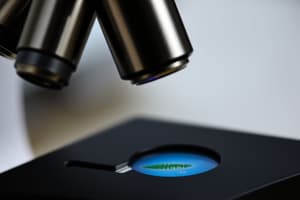Podcast
Questions and Answers
What is the total magnification when viewing a specimen with a 10x eyepiece and a 40x objective lens?
What is the total magnification when viewing a specimen with a 10x eyepiece and a 40x objective lens?
- 400x (correct)
- 50x
- 200x
- 100x
Which parts of a compound microscope are primarily responsible for magnification?
Which parts of a compound microscope are primarily responsible for magnification?
- Eyepiece and Objective Lens (correct)
- Stage and Stage Micrometer
- Body Tube and Base
- Base and Arm
What would be the formula to calculate the calibration factor using the ocular micrometer when only part of the micrometers are visible in the field of view?
What would be the formula to calculate the calibration factor using the ocular micrometer when only part of the micrometers are visible in the field of view?
- CF = Total magnification/Field number
- CF = Eyepiece magnification + Objective magnification
- CF = Ocular micrometer/Stage micrometer unit (10um)
- CF = Stage micrometer unit (10um)/Ocular micrometer unit (correct)
What does the term 'actual size' refer to in microscopy?
What does the term 'actual size' refer to in microscopy?
Which of the following is NOT a mechanical part of a microscope?
Which of the following is NOT a mechanical part of a microscope?
In the context of microscope usage, what does FOV stand for?
In the context of microscope usage, what does FOV stand for?
What is the function of a micrometer in microscopy?
What is the function of a micrometer in microscopy?
How is the field of view affected by changing the objective lens on a microscope?
How is the field of view affected by changing the objective lens on a microscope?
What is the purpose of the coarse knob on a microscope?
What is the purpose of the coarse knob on a microscope?
Which of the following types of microscopes can achieve the highest magnification?
Which of the following types of microscopes can achieve the highest magnification?
What is the maximum magnification power of a compound light microscope?
What is the maximum magnification power of a compound light microscope?
In which type of microscope is the iris diaphragm found?
In which type of microscope is the iris diaphragm found?
Which part of the microscope serves to hold the slide in place?
Which part of the microscope serves to hold the slide in place?
What distinguishes a binocular microscope from a monocular microscope?
What distinguishes a binocular microscope from a monocular microscope?
What is the primary function of the eyepiece in a microscope?
What is the primary function of the eyepiece in a microscope?
What happens to the image produced by a Transmission Electron Microscope?
What happens to the image produced by a Transmission Electron Microscope?
Which microscope utilizes a beam of electrons to create magnified images?
Which microscope utilizes a beam of electrons to create magnified images?
What is the main purpose of the light source in electric microscopes?
What is the main purpose of the light source in electric microscopes?
Flashcards are hidden until you start studying
Study Notes
Microscopy Basics
- Microscopes are essential tools for viewing microorganisms, which are invisible to the naked eye.
- The H.M. Revolving Nosepiece holds objective lenses, allowing for quick changes in magnification.
- The stage supports the specimen slide while the stage clip secures it in place.
Microscopic Components
- Coarse Knob (larger) adjusts stage height for initial focusing, suitable for low power objectives (LPO).
- Fine Adjustment Knob (smaller) provides precise focusing for high power objectives (HPO) and oil immersion objectives (OIO).
Magnifying Parts
- Objective Lens magnifies the image with specific powers: Scanner (4x), LPO (10x), HPO (40x), OIO (100x).
- Eyepiece/Ocular Lens typically has a magnification of 10x.
Types of Microscopes
- Compound Light Microscope: Features both ocular and objective lenses, maximum magnification of 1000x.
- Stereoscope (Dissecting Microscope): Provides lower magnification (up to 100x) for observing surface details.
- Electron Microscope: Utilizes electrons for high-resolution images, with maximum magnification up to 50,000x (Transmission EM for 2D images; Scanning EM for 3D images).
- Atomic Force Microscope: Detects surface topology with a maximum magnification of 1,000,000x.
- Confocal Microscope: Produces images by illuminating thin planes, coupling laser and fluorescence techniques.
Mechanical Parts of Microscope
- The base stabilizes the microscope; the body tube allows light travel from the objective to ocular lens; the arm serves as a handle for transport.
Total Magnification and Field of View
- Total Magnification (TM) is calculated as TM = (eyepiece magnification) x (objective magnification).
- Example calculation: (10x)(40x) results in a TM of 400x.
- Field of View (FOV): the visible area through lenses, calculated as FOV = Field number / Total Magnification.
Micrometry and Measurement Techniques
- Micrometry measures the size of microscopic objects; a micrometer is both an instrument and a unit (micrometers, µm).
- Two techniques for measuring size:
- Estimated Size (ES): Calculated as ES = FOV / Number of specimens across.
- Actual Size (AS):
- Step 1: Determine Calibration Factor (CF) using a stage micrometer and ocular micrometer.
- CF is calculated differently depending on the visibility of micrometers in FOV.
- Step 2: Calculate AS using the formula AS = (CF) x (Ocular units occupied).
- Step 1: Determine Calibration Factor (CF) using a stage micrometer and ocular micrometer.
Calibration Factor Formulas
- Formula 1: CF = Stage micrometer unit (10µm) / Ocular micrometer unit (when micrometers are partially visible).
- Formula 2: CF = Stage micrometer / Ocular micrometer (when micrometers are fully visible).
Studying That Suits You
Use AI to generate personalized quizzes and flashcards to suit your learning preferences.




